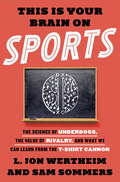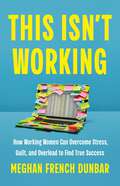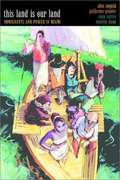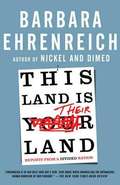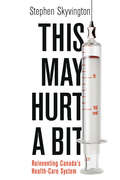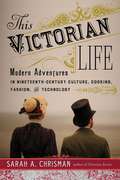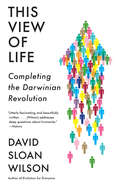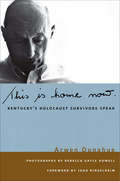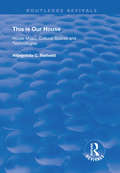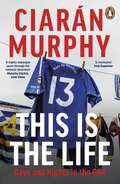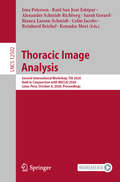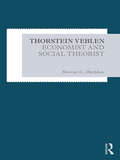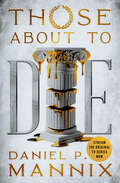- Table View
- List View
This Is Why We Can't Have Nice Things
by Whitney PhillipsInternet trolls live to upset as many people as possible, using all the technical and psychological tools at their disposal. They gleefully whip the media into a frenzy over a fake teen drug crisis; they post offensive messages on Facebook memorial pages, traumatizing grief-stricken friends and family; they use unabashedly racist language and images. They take pleasure in ruining a complete stranger's day and find amusement in their victim's anguish. In short, trolling is the obstacle to a kinder, gentler Internet. To quote a famous Internet meme, trolling is why we can't have nice things online. Or at least that's what we have been led to believe. In this provocative book, Whitney Phillips argues that trolling, widely condemned as obscene and deviant, actually fits comfortably within the contemporary media landscape. Trolling may be obscene, but, Phillips argues, it isn't all that deviant. Trolls' actions are born of and fueled by culturally sanctioned impulses -- which are just as damaging as the trolls' most disruptive behaviors. Phillips describes, for example, the relationship between trolling and sensationalist corporate media -- pointing out that for trolls, exploitation is a leisure activity; for media, it's a business strategy. She shows how trolls, "the grimacing poster children for a socially networked world," align with social media. And she documents how trolls, in addition to parroting media tropes, also offer a grotesque pantomime of dominant cultural tropes, including gendered notions of dominance and success and an ideology of entitlement. We don't just have a trolling problem, Phillips argues; we have a culture problem. This Is Why We Can't Have Nice Things isn't only about trolls; it's about a culture in which trolls thrive.
This Is Why We Can't Have Nice Things: Mapping the Relationship between Online Trolling and Mainstream Culture (The\mit Press Ser.)
by Whitney PhillipsWhy the troll problem is actually a culture problem: how online trolling fits comfortably within today's media landscape.Internet trolls live to upset as many people as possible, using all the technical and psychological tools at their disposal. They gleefully whip the media into a frenzy over a fake teen drug crisis; they post offensive messages on Facebook memorial pages, traumatizing grief-stricken friends and family; they use unabashedly racist language and images. They take pleasure in ruining a complete stranger's day and find amusement in their victim's anguish. In short, trolling is the obstacle to a kinder, gentler Internet. To quote a famous Internet meme, trolling is why we can't have nice things online. Or at least that's what we have been led to believe. In this provocative book, Whitney Phillips argues that trolling, widely condemned as obscene and deviant, actually fits comfortably within the contemporary media landscape. Trolling may be obscene, but, Phillips argues, it isn't all that deviant. Trolls' actions are born of and fueled by culturally sanctioned impulses—which are just as damaging as the trolls' most disruptive behaviors. Phillips describes, for example, the relationship between trolling and sensationalist corporate media—pointing out that for trolls, exploitation is a leisure activity; for media, it's a business strategy. She shows how trolls, “the grimacing poster children for a socially networked world,” align with social media. And she documents how trolls, in addition to parroting media tropes, also offer a grotesque pantomime of dominant cultural tropes, including gendered notions of dominance and success and an ideology of entitlement. We don't just have a trolling problem, Phillips argues; we have a culture problem. This Is Why We Can't Have Nice Things isn't only about trolls; it's about a culture in which trolls thrive.
This Is Your Brain on Sports
by L. Jon Wertheim Sam SommersThis is Your Brain on Sports is the book for sports fans searching for a deeper understanding of the games they watch and the people who play them. Sports Illustrated executive editor and bestselling author L. Jon Wertheim teams up with Tufts psychologist Sam Sommers to take readers on a wild ride into the inner world of sports. Through the prism of behavioral economics, neuroscience, and psychology, they reveal the hidden influences and surprising cues that inspire and derail us--on the field and in the stands--and by extension, in corporate board rooms, office settings, and our daily lives. In this irresistible narrative romp, Wertheim and Sommers usher us from professional football to the NBA to Grand Slam tennis, from the psychology of athletes self-handicapping their performance in the boxing ring or the World Series, to an explanation of why even the glimpse of a finish line can lift us beyond ordinary physical limits. They explore why Tom Brady and other starting NFL quarterbacks all seem to look like fashion models; why fans of teams like the Cubs, Mets, and any franchise from Cleveland love rooting for a loser; why the best players make the worst coaches; why hockey goons (and fans) would rather fight at home than on the road; and why the arena t-shirt cannon has something to teach us about human nature. This is Your Brain on Sports is an entertaining and thought-provoking journey into how psychology and behavioral science collide with the universe of wins-and-losses, coaching changes, underdogs, and rivalry games.
This Isn't Working: How Working Women Can Overcome Stress, Guilt, and Overload to Find True Success
by Meghan French DunbarFrom leadership expert Meghan French Dunbar, &“a timely and necessary book&” (Deepa Purushothaman, author of The First, The Few, The Only) that shows business leaders and workers how to boost performance while improving workplaces for women, and, ultimately, everyone Lean in. Rise and grind. Work smarter, not harder. Many books for women promise tips and tricks to achieve wealth and success in a business world made by men. But on the way to the top, most women leaders (and many men, too!) struggle with anxiety, stress, guilt, and burnout. Playing by the rules in a male-dominated game isn&’t working—for anyone. This Isn&’t Working inspires women to reexamine how we do business and shows there are much healthier, more fulfilling ways to succeed in the business world that don&’t require sacrificing ourselves. In this book, Meghan French Dunbar shares the insights, frameworks, and practical advice she has learned from over a decade of work with impactful women business leaders, from start-up founders to multinational CEOs. She argues that it&’s time to move beyond business cultures marked by competition and aggression and instead embrace healthier leadership and workplace practices, which are proven to yield better results. This Isn&’t Working provides readers with an empathetic and honest business playbook for improving individual and business performance so that everyone can thrive.
This Land Is Our Land: Immigrants and Power in Miami
by Alex Stepick Max J. Castro Marvin Dunn Guillermo GrenierWith vivid ethnographic detail, this book analyzes power, immigration, and inter-ethnic relations in Miami, Florida.
This Land Is Their Land: Reports From a Divided Nation
by Barbara EhrenreichIn her first work of satirical commentary, "The Worst Years of Our Lives," Barbara Ehrenreich skewered the Reagan era. Now she brilliantly dissects one of the cruelest decades in memory--the 2000s--in which she finds a nation scarred by deepening inequality, corroded by distrust, and shamed by its official cruelty.
This Land: America, Lost and Found
by Dan BarryA landmark collection by New York Times journalist Dan Barry, selected from a decade of his distinctive "This Land" columns and presenting a powerful but rarely seen portrait of America. In the wake of Hurricane Katrina and on the eve of a national recession, New York Times writer Dan Barry launched a column about America: not the one populated only by cable-news pundits, but the America defined and redefined by those who clean the hotel rooms, tend the beet fields, endure disasters both natural and manmade. As the name of the president changed from Bush to Obama to Trump, Barry was crisscrossing the country, filing deeply moving stories from the tiniest dot on the American map to the city that calls itself the Capital of the World. Complemented by the select images of award-winning Times photographers, these narrative and visual snapshots of American life create a majestic tapestry of our shared experience, capturing how our nation is at once flawed and exceptional, paralyzed and ascendant, as cruel and violent as it can be gentle and benevolent.
This May Hurt a Bit: Reinventing Canada's Health Care System
by Stephen Skyvington Dr Brian DaySome painful news: Canada no longer has the best health-care system in the world. How might we fix Canada’s health-care system? Why would we want to? What’s stopping us from doing so? These three questions lie at the heart of this in-depth exploration of one of the biggest political and personal issues facing Canadians. Skyvington explains why change has to occur, in light of the implications of doing nothing, and describes how Canadians can and must get involved to save our health-care system. This May Hurt a Bit is meant to provide a blueprint for change once those in charge finally acknowledge the most inconvenient truth — namely, that Canada’s health-care system is in poor health.
This Must Be the Place: How Music Can Make Your City Better
by Shain ShapiroThis Must Be the Place explores how music can make cities better.This Must Be the Place introduces and examines music&’s relationship to cities. Not the influence cities have on music, but the powerful impact music can have on how cities are developed, built, managed and governed.Told in an accessible way through personal stories from cities around the world — including London, Melbourne, Nashville, Austin and Zurich — This Must Be the Place takes a truly global perspective on the ways music is integral to everyday life but neglected in public policy.Arguing for the transformative role of artists and musicians in a post-pandemic world, This Must Be The Place not only examines the powerful impact music can have on our cities, but also serves as a how-to guide and toolkit for music-lovers, artists and activists everywhere to begin the process of reinventing the communities they live in.
This Victorian Life: Modern Adventures in Nineteenth-Century Culture, Cooking, Fashion, and Technology
by Sarah A. ChrismanPart memoir, part micro-history, this is an exploration of the present through the lens of the past. We all know that the best way to study a foreign language is to go to a country where it's spoken, but can the same immersion method be applied to history? How do interactions with antique objects influence perceptions of the modern world? From Victorian beauty regimes to nineteenth-century bicycles, custard recipes to taxidermy experiments, oil lamps to an ice box, Sarah and Gabriel Chrisman decided to explore nineteenth-century culture and technologies from the inside out. Even the deepest aspects of their lives became affected, and the more immersed they became in the late Victorian era, the more aware they grew of its legacies permeating the twenty-first century. Most of us have dreamed of time travel, but what if that dream could come true? Certain universal constants remain steady for all people regardless of time or place. No matter where, when, or who we are, humans share similar passions and fears, joys and triumphs. In her first book, Victorian Secrets, Chrisman recalled the first year she spent wearing a Victorian corset 24/7. In This Victorian Life, Chrisman picks up where Secrets left off and documents her complete shift into living as though she were in the nineteenth century.
This View of Life: Completing the Darwinian Revolution
by David Sloan WilsonIt is widely understood that Charles Darwin’s theory of evolution completely revolutionized the study of biology. Yet, according to David Sloan Wilson, the Darwinian revolution won’t be truly complete until it is applied more broadly—to everything associated with the words “human,” “culture,” and “policy.”In a series of engaging and insightful examples—from the breeding of hens to the timing of cataract surgeries to the organization of an automobile plant—Wilson shows how an evolutionary worldview provides a practical tool kit for understanding not only genetic evolution but also the fast-paced changes that are having an impact on our world and ourselves. What emerges is an incredibly empowering argument: If we can become wise managers of evolutionary processes, we can solve the problems of our age at all scales—from the efficacy of our groups to our well-being as individuals to our stewardship of the planet Earth.
This is Home Now: Kentucky's Holocaust Survivors Speak (Kentucky Remembered: An Oral History Series #Kyre)
by Arwen DonahueA look at the lives of nine Jewish Holocaust survivors after their liberation from Nazi concentration camps, when they settled in rural Kentucky.At the end of World War II, many thousands of Jewish Holocaust survivors immigrated to the United States from Europe in search of a new beginning. Most settled in major metropolitan areas, usually in predominantly Jewish communities, where proximity to coreligionists offered a measure of cultural and social support. However, some survivors settled in smaller cities and rural areas throughout the country, including in Kentucky, where they encountered an entirely different set of circumstances. Although much scholarship has been devoted to Holocaust survivors living in major cities, little has been written about them in the context of their experiences elsewhere in America.This Is Home Now: Kentucky’s Holocaust Survivors Speak presents the accounts of Jewish survivors who resettled outside of the usual major metropolitan areas. Using excerpts from oral history interviews and documentary portrait photography, author Arwen Donahue and photographer Rebecca Gayle Howell tell the fascinating stories of nine of these survivors in a unique work of history and contemporary art. The book focuses on the survivors’ lives after their liberation from Nazi concentration camps, illuminating their reasons for settling in Kentucky, their initial reactions to American culture, and their reflections on integrating into rural American life.Praise for This is Home Now“Until Donahue and Howell turned their recorders and cameras on these well-chosen survivors living in Kentucky, no one had taken the time to ask how these solitary transplants made new lives for themselves and their children in rural middle America. The stories and images reproduced in this book are both moving and arresting. We owe Donahue and Howell a great debt for rescuing them before they disappeared down the trapdoor of historical memory.” —Lawrence N. Powell, author of Troubled Memory: Anne Levy, the Holocaust, and David Duke's Louisiana“Each of the stories can stand on its own as a fascinating example of what has transpired for Jews outside of New York City.” —David Wallace, Community (Jewish Community Association of Louisville)“This Is Home Now focuses on the overlooked stories of Holocaust survivors who relocated to the commonwealth.” —Lexington Herald-Leader
This is Our House: House Music, Cultural Spaces and Technologies (Routledge Revivals)
by Hillegonda C. RietveldOriginally published in 1998. House music has had a considerable influence in shaping the sound of pop music from the late 1980s onwards. From underground dance events to the pop charts, traces of this aesthetic can be found in many guises. This book traces a genealogy of house and maps some of the power structures that are at play in its production and consumptoin. Places like Chicago, New York, London, Manchester, Amsterdam and Rotterdam have been visited, providing the material to discuss such subjects as contemporary dance culture, DJs and the roles of musical technologies. The author, Hillegonda Rietveld, was already steeped in dance club culture before she decided to write this loving piece of academic prose about house. Taking critical culture studies as its aesthetic fuel, she ram-raids boundaries of academic disciplines, fusing ideas like a meticulous DJing curator.
This is Sociology: A Short Introduction
by Dan Woodman Steven ThreadgoldThis is Sociology is an engaging, concise introduction to the key concepts used for studying social life. It covers a diverse range of theorists from the rich history of sociology and shows how thinking sociologically can help us understand our lives, the groups we are part of, and the rapid social changes and inequalities that shape contemporary societies. Key features: Uses compelling international examples and a range of theoretical perspectives from across the world, including theorists that have often been omitted from the established sociological canon. Covers topics such as globalization, culture, gender, race, and class. Introduces the latest approaches emerging from efforts to build an inclusive global sociology, one that moves beyond a Eurocentric perspective and is equipped for the challenges of the 21st Century. The book is essential reading for anyone new to studying sociology and is supported by a wide range of podcasts, videos, and discussion questions.
This is Sociology: A Short Introduction
by Dan Woodman Steven ThreadgoldThis is Sociology is an engaging, concise introduction to the key concepts used for studying social life. It covers a diverse range of theorists from the rich history of sociology and shows how thinking sociologically can help us understand our lives, the groups we are part of, and the rapid social changes and inequalities that shape contemporary societies. Key features: Uses compelling international examples and a range of theoretical perspectives from across the world, including theorists that have often been omitted from the established sociological canon. Covers topics such as globalization, culture, gender, race, and class. Introduces the latest approaches emerging from efforts to build an inclusive global sociology, one that moves beyond a Eurocentric perspective and is equipped for the challenges of the 21st Century. The book is essential reading for anyone new to studying sociology and is supported by a wide range of podcasts, videos, and discussion questions.
This is Your Brain on Stereotypes: How Science Is Tackling Unconscious Bias
by Tanya Lloyd KyiFrom the time we're babies, our brains constantly sort and label the world around us—a skill that's crucial for our survival. But, as adolescents are all too aware, there's a tremendous downside: when we do this to groups of people it can cause great harm. <p><p>Here's a comprehensive introduction to the science behind stereotypes that will help young people make sense of why we classify people, and how we can change our thinking. Besides the many ways this book could be used to inspire frank and in-depth discussions on the importance of addressing stereotypes and bias, it also links to many science and social studies curriculum topics.
This is the Life: Days and Nights in the GAA
by Ciarán MurphyA provocative look at how grassroots GAA interacts with life in Ireland, from the wittiest Gaelic games pundit at work today The GAA is Ireland's largest civil society organisation, woven into the fabric of families and communities - and yet most books about Gaelic games focus on the greatest players and inter-county teams. This is the Life is a book about the 99%: a witty and provocative look at grassroots GAA from the most intelligent and interesting Gaelic games pundit at work today.Ciarán Murphy - of Second Captains and the Irish Times - has an unmatched feel for the timeless elements of this world and a finger on the pulse of change. He looks at the plight of rural clubs that are losing their players to the cities - and he does so not only as a journalist but as a footballer who made the same move himself. He writes about working as an assistant in the clothing shop owned by the family of Jarlath Fallon - both Ciarán's sporting hero and the local postman. And he looks a things we usually prefer not to talk about, like the role of social class in the GAA.This is the Life is a book about the places the GAA comes from, the places it can take a person, and theings that make a local club worth fighting for.
Thomas Jefferson's Philosophy of Education: A utopian dream (New Directions in the Philosophy of Education)
by M. Andrew HolowchakThomas Jefferson had a profoundly advanced educational vision that went hand in hand with his political philosophy - each of which served the goal of human flourishing. His republicanism marked a break with the conservatism of traditional non-representative governments, characterized by birth and wealth and in neglect of the wants and needs of the people. Instead, Jefferson proposed social reforms which would allow people to express themselves freely, dictate their own course in life, and oversee their elected representatives. His educational vision aimed to instantiate a progressive social climate only dreamed of by utopists such as Thomas More, James Harrington and Louis-Sébastian Mercier. This book offers a critical articulation of the philosophy behind Jefferson’s thoughts on education. Divided into three parts, chapters include an analysis of his views on elementary and higher education, an investigation of education for both the moral-sense and rational faculty, and an examination of education as lifelong learning. Jefferson’s educational rationale was economic, political and philosophical, and his systemic approach to education conveys a systemic, economic approach to living, with strong affinities to Stoicism. Thomas Jefferson’s Philosophy of Education will be key reading for philosophers, historians and postgraduate students of education, the history of education and philosophy.
Thomas Pynchon and American Counterculture
by Joanna FreerThomas Pynchon and the American Counterculture employs the revolutionary sixties as a lens through which to view the anarchist politics of Pynchon's novels. Joanna Freer identifies and elucidates Pynchon's commentaries on such groups as the Beats, the New Left and the Black Panther Party and on such movements as the psychedelic movement and the women's movement, drawing out points of critique to build a picture of a complex countercultural sensibility at work in Pynchon's fiction. In emphasising the subtleties of Pynchon's responses to counterculture, Freer clarifies his importance as an intellectually rigorous political philosopher. She further suggests that, like the graffiti in Gravity's Rainbow, Pynchon creates texts that are 'revealed in order to be thought about, expanded on, translated into action by the people', his early attraction to core countercultural values growing into a conscious, politically motivated writing project that reaches its most mature expression in Against the Day.
Thoracic Image Analysis: Second International Workshop, TIA 2020, Held in Conjunction with MICCAI 2020, Lima, Peru, October 8, 2020, Proceedings (Lecture Notes in Computer Science #12502)
by Sarah Gerard Jens Petersen Kensaku Mori Colin Jacobs Bianca Lassen-Schmidt Raúl San José Estépar Alexander Schmidt-Richberg Reinhard BeichelThis book constitutes the proceedings of the Second International Workshop on Thoracic Image Analysis, TIA 2020, held in Lima, Peru, in October 2020. Due to COVID-19 pandemic the conference was held virtually. COVID-19 infection has brought a lot of attention to lung imaging and the role of CT imaging in the diagnostic workflow of COVID-19 suspects is an important topic. The 14 full papers presented deal with all aspects of image analysis of thoracic data, including: image acquisition and reconstruction, segmentation, registration, quantification, visualization, validation, population-based modeling, biophysical modeling (computational anatomy), deep learning, image analysis in small animals, outcome-based research and novel infectious disease applications.
Thoreau's Axe: Distraction and Discipline in American Culture
by Caleb SmithHow nineteenth-century “disciplines of attention” anticipated the contemporary concern with mindfulness and being “spiritual but not religious”Today, we’re driven to distraction, our attention overwhelmed by the many demands upon it—most of which emanate from our beeping and blinking digital devices. This may seem like a decidedly twenty-first-century problem, but, as Caleb Smith shows in this elegantly written, meditative work, distraction was also a serious concern in American culture two centuries ago. In Thoreau’s Axe, Smith explores the strange, beautiful archives of the nineteenth-century attention revival—from a Protestant minister’s warning against frivolous thoughts to Thoreau’s reflections on wakefulness at Walden Pond. Smith examines how Americans came to embrace attention, mindfulness, and other ways of being “spiritual but not religious,” and how older Christian ideas about temptation and spiritual devotion endure in our modern ideas about distraction and attention.Smith explains that nineteenth-century worries over attention developed in response to what were seen as the damaging mental effects of new technologies and economic systems. A “wandering mind,” once diagnosed, was in need of therapy or rehabilitation. Modeling his text after nineteenth-century books of devotion, Smith offers close readings of twenty-eight short passages about attention. Considering social reformers who designed moral training for the masses, religious leaders who organized Christian revivals, and spiritual seekers like Thoreau who experimented with regimens of simplified living and transcendental mysticism, Smith shows how disciplines of attention became the spiritual exercises of a distracted age.
Thorstein Veblen: A Critical Interpretation
by David RiesmanThis is a brilliant and unconventional study of one of the most challenging figures in modern social and economic thought. David Riesman has chosen a deliberately personal method of exposition and evaluation, and he is by no means a disciple. He says of Veblen: 'I find him more often interesting than attractive, more often pungent than wise.' By approaching Veblen subjectively and in a critical spirit, Riesman has arrived at an estimate of the man that is objective and balanced.Veblen's ideas and attitudes are carefully examined, with particular attention to his conviction that 'the instinct of workmanship' was the constructive element in life, and to his fundamental principle of 'idle curiosity.' Veblen is seen as a man with a passionate moral sense whose method was irony coupled with research. Riesman makes the interesting point that the author of The Theory of the Leisure Class was episodically a passionate, even revolutionary reformer, in contrast to a career primarily as an intellectual skeptic.Riesman looks behind the ideas, searching for their origins in Veblen's life, with the result that one finishes the book with a genuine sense of the strange man who is its subject. Riesman concludes that Thorstein Veblen is important not so much for his specific contribution to economic thought as for his stance toward the economy and his fellow economists. For us today, Riesman adds, Veblen's great value inheres in his way of seeing. The new introduction by Mestrovic provides an appreciation of Riesman, no less than Veblen.David Riesman is the Henry Ford II Professor Emeritus of Social Sciences at Harvard University. He has also taught at the University of Chicago, and Johns Hopkins University. Among his most important books are The Lonely Crowd; Faces in the Crowd; Individualism Reconsidered; and Constraint and Variety in American Education. His collection, Abundance for What?, confirms his place as the foremost sociologist of education in the modern era.Stjepan G. Mestrovic is a senior social theorist in his own right. He is currently located at Texas A&M University, where he is a professor of sociology.
Thorstein Veblen: Economist and Social Theorist
by Murray G. MurpheyIn his latest book, scholar-historian Murray G. Murphey exhaustively explores the life and theory of Thorstein Veblen (1857–1929), whom, many scholars agree, remains one of the leading social theorists of all time, if not also one of the more confounding. Murphey’s account begins with a brief economic history of nineteenth-century America, wherein he examines the conditions that formed Veblen’s ideology. With that understanding, the author studies Veblen’s personal history and brings to the fore his foundational ideas on human psychology, race, his theory of knowledge, and his analysis of social evolution. In the book’s later chapters, Murphey considers Veblen’s writing through the scope of his major volumes – The Theory of the Leisure Class, The Theory of Business Enterprise, and Imperial Germany and the Industrial Revolution, among others. Spanning the latter stages of the nineteenth century into the first several decades of the twentieth century, Murphey traces Veblen’s radical economics and thinking within the broader context of America’s economic theory. In so doing, he upholds Veblen’s influence on the canons of economics and social science, and importantly, he attempts to resolve the lingering mystery behind one of America’s more puzzling and influential theorists.
Those About to Die
by Daniel P. MannixThe basis for the new Peacock television series: The classic, in-depth account of the ancient Romans&’ obsession with the bloody and brutal gladiatorial games. &“If you can imagine a superior American sports writer suddenly being transported back in time to cover the ancient Roman games, you will have some idea of the flavor and zest of [Those About to Die],&” said the Los Angeles Times about Daniel P. Mannix&’s century-by-century—and nearly moment-by-moment—narrative of the Roman Empire&’s national institution. Putting the games in the context of Rome&’s rise and dramatic fall, Mannix captures all the history, planning, and savage pageantry that went into creating the first spectator sports. The games began in 238 BC as nearly county fair–like entertainment, with trick riding, acrobats, trained animals, chariot racing, and athletic events. The contests then evolved into slave fights thanks to wealthy patricians Marcus and Decimus Brutus, who wanted to give their father an unforgettable funeral by reviving an old tradition. What the brothers wrought, Rome devoured, demanding even greater violence to satisfy the bloodlust of the crowd. Architectural wonders in themselves, massive arenas like Circus Maximus and the Colosseum were built, able to host sea battle reenactments on actual water. Successful gladiators found fame, fortune—and freedom. But as Rome began to fall in the fifth century, so did the games, devolving into nothing more than pointless massacres. In the end, millions of humans and animals were sacrificed in barbaric displays. What were once ceremonies given in honor of gods met an inglorious fate, yet they still captivate the imagination of people today.


